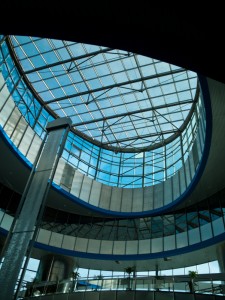New Technology Redirects Sunlight in Buildings
Researchers at the University of Cincinnati have developed a technology that might change how the interiors of future buildings are lit.
 Using light from the sun, the tech illuminates rooms without windows as well as rooms deep inside buildings where natural light does not usually reach.
Using light from the sun, the tech illuminates rooms without windows as well as rooms deep inside buildings where natural light does not usually reach.
The new technology, called SmartLight, is the result of a collaboration between University of Cincinnati researchers Anton Harfmann and Jason Heikenfeld.
The tech uses tiny electrofluidic cells and open-air ducts to enable sunlight to naturally illuminate windowless work spaces. The system does not require the installation of new wiring, ducts or cables. Excess light can be harvested, stored and directed to other applications.
“The SmartLight technology would be groundbreaking. It would be game changing,” says Harfmann, an associate professor in UC’s School of Architecture and Interior Design. “This would change the equation for energy. It would change the way buildings are designed and renovated. It would change the way we would use energy and deal with the reality of the sun. It has all sorts of benefits and implications that I don’t think we’ve even begun to touch.”
The basis behind SmartLight is using sunlight in a smarter way. Each day the earth receives enough energy from sunlight to satisfy many of our energy demands, but our technologies aren’t efficiently harnessing that energy. With SmartLight, sunlight is channeled through the system and used in its original form, unlike other technologies where light is converted into electricity and then back into light.
While the technology could be used in any type of building, the researchers believe it will have the most impact in large commercial buildings because their energy demands make those buildings big energy wasters. During 2011, 21% of commercial electrical consumption was for lighting, according to the U.S. Department of Energy.
SmartLight uses a grid of electrofluidic cells self-powered by photovoltaics and applied on windows. Each cell contains fluid with optical properties similar to glass.
The surface tension of the fluid can be manipulated into shapes with minimal electrical stimulation, requiring 10,000 to 100,000 times less power than what’s used to illuminate an incandescent bulb, according to the UC researchers.
Sunlight coming through each cell is controllable. For example, the grid can direct light to reflect off a ceiling to provide room lighting or direct it toward fixtures for task lighting (office lighting).
The plan is for a mobile software application to control SmartLight wirelessly, requiring no light switches or electricity lines. SmartLight’s energy storage capability would funnel surplus light into an energy-storage hub on sunny days. When it’s cloudy outside and the levels of natural light are low, the stored energy can be used to beam electrical lighting into the building.
Next Steps:
- Subscribe to our blog to receive the full blog series via email and stay informed about the latest HVAC news and insight.
- Stay up to date on facility maintenance tools such as chiller tube cleaners, boiler tube cleaners, hose/pipe cleaners, descaler systems, industrial vacuums, commercial pressure washers, and drain cleaners.


Quigley
Look forward to following this technology. Efficiency is the key.